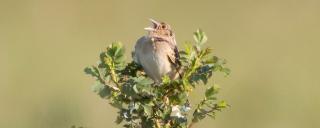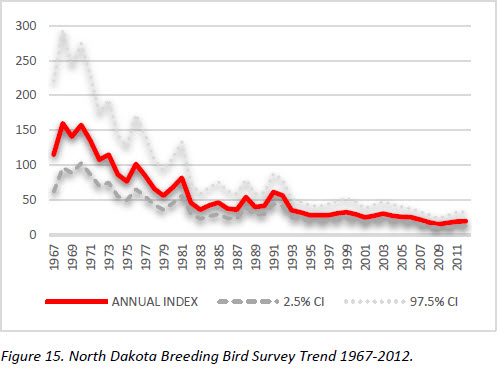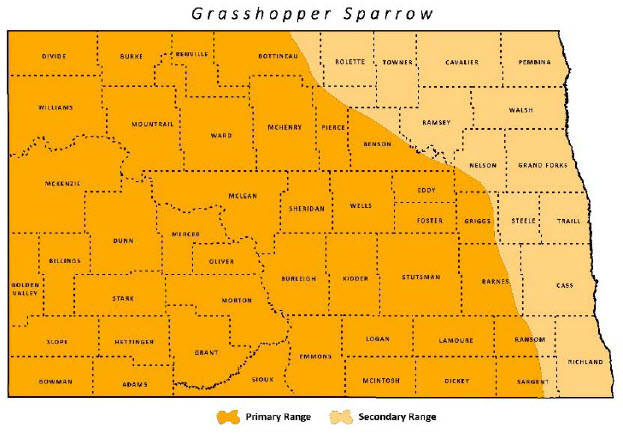
Grasshopper Sparrow
| Scientific Name | Ammodramus savannarum |
|---|---|
| General Description | L 5”, WS 7.75”,0.6 oz. Short-tailed, flat-headed, yellowish with an unstreaked breast. Yellow spot between the eyes and bill. |
| Status | Occurs in North Dakota from mid-April to mid-September. Peak breeding season early June to late July. |
| Abundance | Common. |
| Primary Habitat | Idle or lightly grazed tall or mixed-grass prairie, shrub prairie meadows, and hayfields. |
| Federal Status | Migratory Bird. |
| Reason for Designation | Significantly declining nationwide. It is included on the USFWS Birds of Conservation Concern list in Region 6, BCR 11 and 17 Partners in Flight (PIF) identifies the Grasshopper Sparrow as a Regional Concern and Stewardship Species, U.S.-Canada Stewardship Species, and a Common Bird in Steep Decline. |
Locations and Conditions of Key Habitat
Preferred Habitat
Grasslands of intermediate height, clumped vegetation, patches of bare ground, moderate litter depth, and sparse woody vegetation are preferred. Uses native and tame grasslands, CRP, hayland, and occasionally cropland. Abundance positively correlated with percent grass cover, litter depth, visual obstruction, density of lowgrowing shrubs, and areas of shrubs and introduced grasses. Negatively correlated with percent clubmoss and areas dominated by solely native grass. Nest on the ground and well concealed by overhanging grasses. May be area sensitive and require large grasslands although territory size is small less than 2 ha. Forages on the ground for insects, including grasshoppers.
Key Areas and Conditions for Grasshopper Sparrow in North Dakota
No specific sites have been identified. Present statewide, but may be more abundant in the southern portion of the state.
Problems Which May Affect this Species
Habitat
Conversion of grassland to cropland, energy development and urban expansion. Degradation of grasslands from invasive plants, woody encroachment, succession, and loss of diversity. Grasshopper Sparrows respond positively to prescribe burns. The first year after a burn, densities are low but become most abundant 2-4 years post-fire. Lack of prescribed burns in grasslands could negatively affect this species. Deemed woodland-sensitive, occurrence declines with increasing tall shrub (>1m) cover. Increased woodland cover negatively affects this species, as maximum occurrence is in open, treeless grasslands. CRP has been very beneficial to the species, and loss of CRP would negatively affect the population.
Other Natural or Manmade Factors
Parasitism by brown-headed cowbirds may be higher than for other grassland birds. Nest depredation is the most important factor affecting nest success, followed by weather. Pesticide acute toxicity may be a potential contributor to declines of grassland birds. Mortality from collisions with communication towers. Grassland birds avoid habitat within 150 meters of roads and 350 meters of oilfield infrastructure, likely due to anthropogenic disturbance of heavy traffic and/or changes in habitat near oil development.
Research and Survey Efforts
Current Research or Surveys
- Rocky Mountain Bird Observatory (ND SWG T-46-R) is estimating demographic rates of Grasshopper Sparrow and other grassland birds in western North Dakota. A final report is anticipated in 2018.
Previous Research or Surveys
- University of Montana (ND SWG T-1-R) developed breeding bird models which link population density to local and landscape habitat features in the Prairie Pothole Region of North Dakota. Grasshopper Sparrow was one of 16 grassland bird focal species. The project was initiated in 2002, a final report was provided in 2004 (Naugle 2005), and dissertation in 2007 (Quamen 2007). Further analysis of the data was recently or selection for grassland at both the landscape and local scales and showed negative relationship to visual obstruction.
- University of North Dakota (ND SWG T2-8-R) determine grassland songbird response to landscape composition and vegetation. The project was initiated in 2010, a final report was provided in 2012 (Dixon and Goodwin 2013), and thesis in 2013 (VanThuyne 2013).
- The Nature Conservancy (T-23-R) implemented adaptive grassland management at Davis Ranch. The project was initiated in 2008, a final report was provided in 2010 (Rosenquist 2011), Grasshopper Sparrows are one of the most common grassland birds.
- Several studies which include Grasshopper Sparrow and multiple other grassland associated species have taken place in North Dakota. Examples include the benefits of CRP to grassland nesting passerines and the effects of various management practices.
- Numerous published reports and gray literature on this species throughout its range.
Additional Research or Surveys Needed
Nothing identified at this time.
Population and Trend Estimates

- PIF Global Population Estimate: 31,000,000
- PIF North American Population Estimate: 30,000,000
- PIF North Dakota Population Estimate: 4,000,000
- North Dakota BBS Trend: see figure 15
- Survey-wide BBS Trend 1966-2012: -2.86
Management Recommendations
- Protect or create large tracts of grassland, particularly native prairie.
- Prevent encroachment of woody vegetation in grasslands.
- Burn, mow, or graze on a rotational schedule.
- Encourage no-till/minimum till when possible.
- Delay mowing until July 15.
- Construction of communication towers should follow the guidance of “Service Interim Guidelines for Recommendations on Communications Tower Siting, Construction, Operation, and Decommissioning” and American Bird Conservancy Collision Program framework.
Monitoring Plans
According to the Partners in Flight Landbird Conservation Plan, long-term population trend monitoring such as the Breeding Bird Survey is generally considered adequate, but may not account for some issues (e.g. bias). Ensuring all BBS routes are conducted annually is priority. Future monitoring proposals should follow recommendations North American Bird Conservation Initiative ‘Opportunities for Improving Avian Monitoring’
2005-2015 Progress
The Grasshopper Sparrow remains a Level I Species of Conservation Priority. Several State Wildlife Grant Projects (T2-11-HM, T-18-R, T-20-D, T-21-D, T-22-HM, T-23- HM, T-25-HM, T-28-L, T-37-D) have contributed to habitat enhancement grasslands for Grasshopper Sparrows and other grassland dependent birds.

Note: A listing of works consulted when compiling the information on this page may be found in the 2015 State Wildlife Action Plan.
